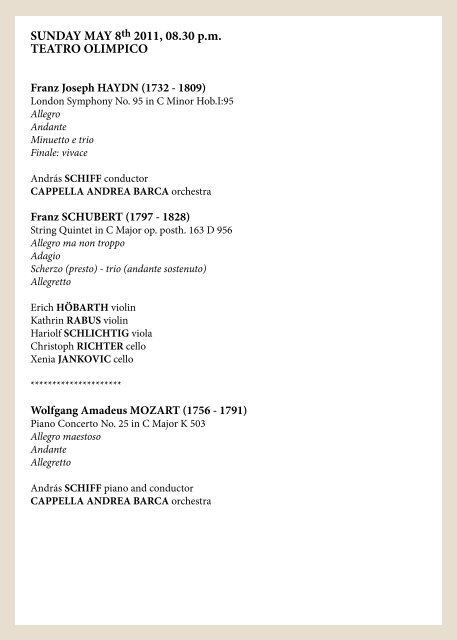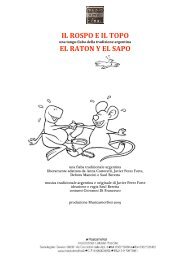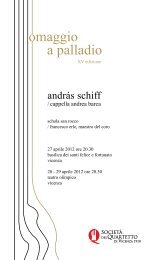ANDRÁS SCHIFF - Società del Quartetto di Vicenza
ANDRÁS SCHIFF - Società del Quartetto di Vicenza
ANDRÁS SCHIFF - Società del Quartetto di Vicenza
You also want an ePaper? Increase the reach of your titles
YUMPU automatically turns print PDFs into web optimized ePapers that Google loves.
SUNDAY MAY 8 th 2011, 08.30 p.m.<br />
TEATRO OLIMPICO<br />
Franz Joseph HAYDN (1732 - 1809)<br />
London Symphony No. 95 in C Minor Hob.I:95<br />
Allegro<br />
Andante<br />
Minuetto e trio<br />
Finale: vivace<br />
András <strong>SCHIFF</strong> conductor<br />
CAPPELLA ANDREA BARCA orchestra<br />
Franz SCHUBERT (1797 - 1828)<br />
String Quintet in C Major op. posth. 163 D 956<br />
Allegro ma non troppo<br />
Adagio<br />
Scherzo (presto) - trio (andante sostenuto)<br />
Allegretto<br />
Erich HÖBARTH violin<br />
Kathrin RABUS violin<br />
Hariolf SCHLICHTIG viola<br />
Christoph RICHTER cello<br />
Xenia JANKOVIC cello<br />
*********************<br />
Wolfgang Amadeus MOZART (1756 - 1791)<br />
Piano Concerto No. 25 in C Major K 503<br />
Allegro maestoso<br />
Andante<br />
Allegretto<br />
András <strong>SCHIFF</strong> piano and conductor<br />
CAPPELLA ANDREA BARCA orchestra<br />
When Prince Nikolaus I Esterhazy <strong>di</strong>ed in 1790, Haydn happened to be in the awkward situation<br />
of being a Kapellmeister without an orchestra: the Prince’s son, Anton, in fact had <strong>di</strong>sbanded<br />
the Court orchestra but had ensured the composer a guaranteed income. In this way<br />
Haydn, who had been entirely busy to provide music for the Court, was free and could accept,<br />
in 1791, the invitation of the music manager Salomon to go to London, where he had a huge<br />
reputation and he met an outstan<strong>di</strong>ng success with the concerts for which he composed his<br />
last twelve symphonies, the so called London Symphonies.<br />
In this group the Symphony No. 95 has some features: it is the only one in a minor key and<br />
without a slow introduction. In spite of the chosen key, the work keeps the brightness which<br />
<strong>di</strong>stinguishes Haydn’s lasts symphonies: the light and shade effects don’t darken the character<br />
and the music is <strong>di</strong>rect and comprehensible; Haydn, a really experienced symphonist, is able<br />
to flatter the au<strong>di</strong>ence without becoming pre<strong>di</strong>ctable and repetitive.<br />
In music tra<strong>di</strong>tion, the string quintet has always been less popular than the quartet: it is even<br />
more unusual to find quintets with two violins, two cellos and only one viola.<br />
If we don’t mention George Onslow, neglected by history, the 113 quintets by Boccherini are<br />
the only important precedent to the Quintet in C major by Franz Schubert: the introduction<br />
of a second cello instead of a second viola gives more importance to the bass voices and<br />
achieves a deeper tone.<br />
Schubert uses instruments to create an almost orchestral volume and the work nearly reaches<br />
the range of a symphony, as announced by the first wide movement and strengthened by the<br />
wonderful Trio, piece of rare depth; the slow movement arises from the contrast of two <strong>di</strong>fferent<br />
thematic sections: the first segment is quiet and peaceful while the other is nervous and<br />
intense. The Quintet was published several years after Schubert’s death.<br />
Between 1784 and 1786 Mozart wrote twelve piano concertos: the persistence on this music<br />
genre and on this instrument reveals that the composer had found a special way to express himself;<br />
the great series of works ends with the Concerto No. 25, K503. Unlike some other concerts,<br />
it shows a remarkable symphonic characteristic, that can be noticed since the first bars, majestically<br />
stressed by all instruments; so, it is closed to Prague Symphony K 504 not only because it<br />
was composed in the same years, but for the importance given to the orchestra: this is no more<br />
the background on which the soloist <strong>di</strong>splays his outstan<strong>di</strong>ng virtuosity but it plays a lea<strong>di</strong>ng<br />
role in the work. In the final Rondo Mozart uses a theme taken from a gavotte of the ballet music<br />
for Idomeneo, written in 1781, and he generates a movement based on the alternation of the<br />
piano and sections of the orchestra, such as winds, creating a very close <strong>di</strong>alog.<br />
Andrea Scarpari




